The Best Stablecoins of 2025: USDT vs. USDC vs. The Challengers
The stablecoin market is no longer a quiet corner of the digital world. It’s a roaring force of nature, with transaction volumes now standing shoulder-to-shoulder with payment titans like Visa and Mastercard. With a collective market cap hurtling past $250 billion and on a trajectory to hit trillions, stablecoins have shed their niche status. They are now a foundational layer for the future of finance.
The ground shifted fundamentally in July 2025. The passage of the Guiding and Establishing National Innovation for U.S Stablecoins (GENIUS) Act wasn’t just another piece of legislation. It was a starting gun, firing off a new era of regulatory clarity and institutional adoption that is reshaping global commerce. You can dive deeper into this landmark law in our strategic field manual for the GENIUS ACT.
For the savvy crypto professional, the question is no longer if they should use stablecoins, but which one to trust. The market is a complex tapestry. It’s woven with threads of centralized giants, decentralized innovators, and a new breed of regulated contenders from the biggest names in finance. A wrong choice could mean unacceptable regulatory risk, a catastrophic counterparty failure, or simply missing the boat on a tidal wave of opportunity in a digital-first economy.
This is your definitive guide. We provide a comprehensive stablecoin comparison for 2025, dissecting the titans (USDT vs USDC), evaluating the new wave of regulated players (PayPal's PYUSD, Ripple's RLUSD), and analyzing the decentralized challengers (DAI, USDe, FRAX). Our goal is to arm you—the business owner, the developer, the investor—with a strategic framework to select the best stablecoin for your mission, whether that’s high-frequency trading, enterprise payments, or long-term value preservation.
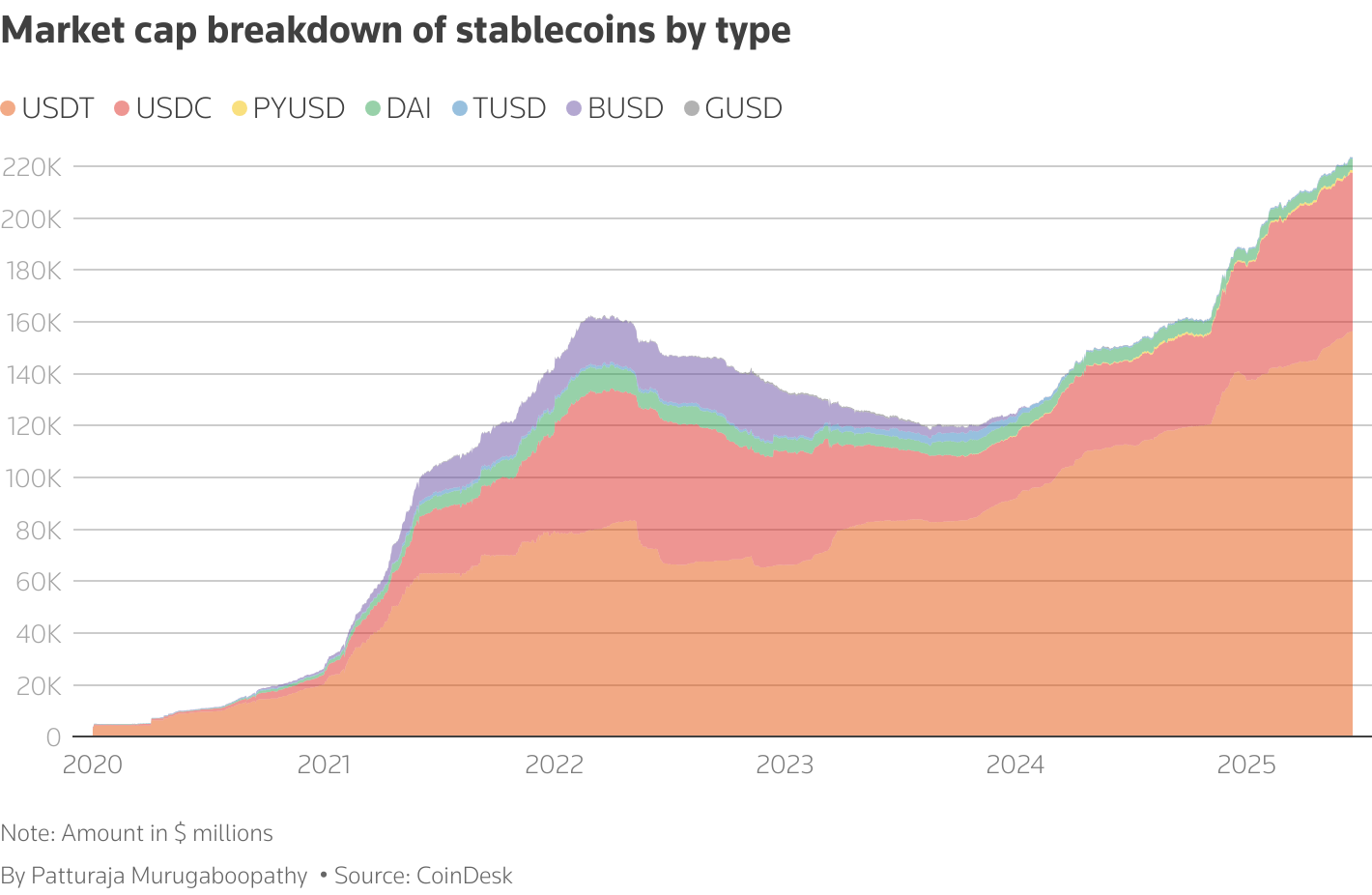
What Are Stablecoins and Why Do They Matter More Than Ever?
At its core, a stablecoin is a cryptocurrency designed to hold a stable value by pegging its price to an external reference, like the U.S. dollar. This simple principle of stability is what sets them apart from the wild price swings of assets like Bitcoin (BTC) or Ethereum. By minimizing volatility, stablecoins act as a reliable bridge between the old world of traditional finance and the new world of blockchain.
"Stablecoins are at a turning point. The passage of the GENIUS Act by the U.S. Congress signals a new era of regulatory clarity and confidence in digital assets." - Mastercard
Stablecoins are the lifeblood of the modern crypto economy. They are the primary trading pair on nearly every exchange, accounting for an estimated 80% of trade volume on major platforms. This allows traders to move seamlessly between volatile assets and a stable, digital dollar without ever touching a traditional bank account, providing 24/7 liquidity that has become the bedrock of the market.
But the real story is happening beyond the trading floors. The most explosive growth in stablecoin adoption is in real-world business applications. Because they operate on global blockchains that never sleep, stablecoins enable near-instant settlement of funds across borders. This isn’t just an improvement. It’s a revolution, shattering the limitations of a banking system shackled by business hours, weekends, and holidays. The ability to move value globally in minutes for a fraction of the cost of a wire transfer is a paradigm shift for global commerce, which is why giants like Visa, Stripe, and PayPal are now building their enterprise solutions on stablecoin rails.
This rising prominence has elevated stablecoins from a financial tool to a matter of geopolitical strategy. The GENIUS Act explicitly aims to ensure the "U.S. Dollar Global Reserve Currency Status." By mandating that compliant U.S. stablecoins be backed by cash and short-term U.S. Treasury bills, the law creates a powerful feedback loop. As a result, stablecoins are now a primary way the U.S. dollar is spreading globally in a digital, accessible format, especially in nations like Argentina and Turkey fighting hyperinflation.
To make that strategic choice, you first need to understand how these different stablecoins are built.
The Four Architectures of Stability: A Deep Dive into Stablecoin Models
To properly compare the leading stablecoins, you have to look under the hood. Each model operates on a different foundation of trust and comes with a unique set of trade-offs.
Fiat-Backed (The Custodial Model): Trust in Institutions
This is the most common and straightforward model. Fiat-backed stablecoins are collateralized 1:1 by reserves of cash and highly liquid assets like U.S. Treasury bills. A central company holds these reserves in regulated bank accounts. The peg is maintained through a simple arbitrage mechanism: you can always create a new token by depositing $1 with the issuer, and you can always redeem a token for $1 from the reserves.
- Examples: Tether (USDT), USDC, PYUSD, RLUSD, FDUSD.
- Core Trade-off: This model offers rock-solid price stability and user trust. However, it’s centralized. You must trust the issuer to maintain its reserves and honor redemptions, and the issuer can freeze assets at the request of law enforcement.
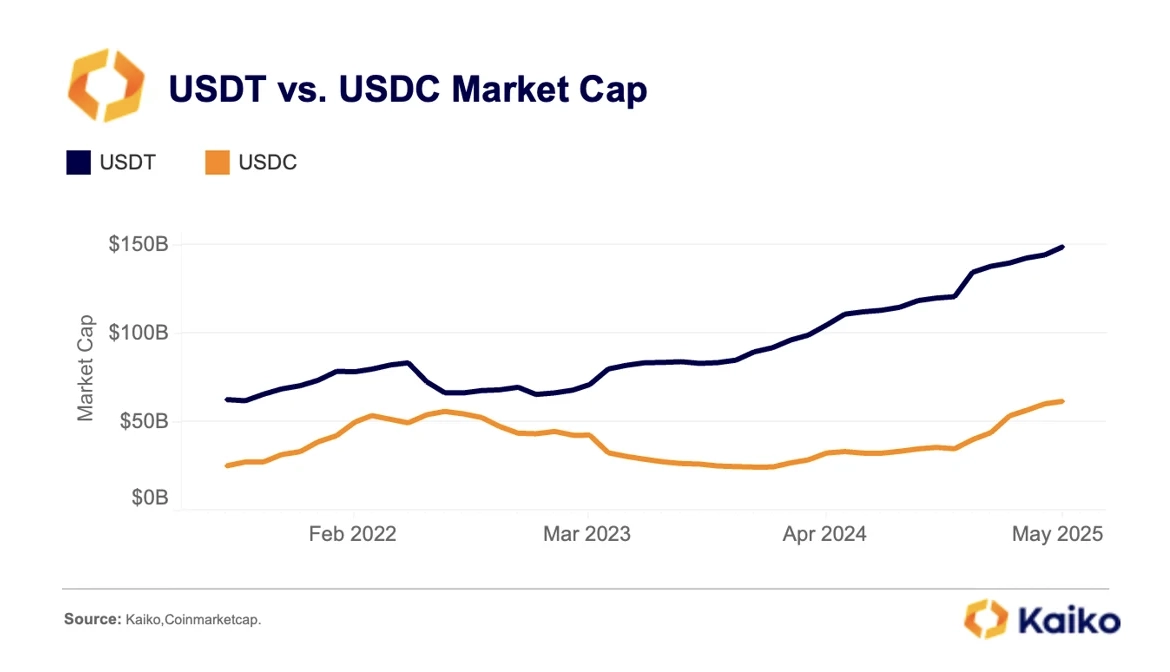
Crypto-Backed (The Decentralized Model): Trust in Code
Crypto-backed stablecoins aim for decentralization by using other cryptocurrencies as collateral. To handle the price volatility of assets like Ethereum, these systems are "over-collateralized." This means a user must lock up more than $1 worth of a volatile crypto to mint $1 of the stablecoin. The peg is maintained by smart contracts that automatically liquidate collateral if its value drops too low.
- Example: DAI.
- Core Trade-off: The main advantage is decentralization and censorship resistance. However, this comes at the cost of lower capital efficiency and exposure to the systemic risks of the broader crypto market.
Algorithmic & Hybrid (The New Frontier): Trust in Incentives
This is the bleeding edge of stablecoin design, using complex algorithms and economic incentives to maintain the peg.
- Fractional-Algorithmic (FRAX): A hybrid model, FRAX is partially backed by hard collateral (like USDC) and partially by its own governance token (FXS). Its key innovation is a dynamic Collateral Ratio (CR). If the market has high confidence in FRAX (trading above $1), the protocol algorithmically requires less hard collateral to mint new tokens. If confidence wanes (trading below $1), it demands more.
- Synthetic Dollar (USDe): Ethena's USDe isn’t backed by traditional reserves. It maintains its peg through a "delta-neutral" hedge. The protocol takes collateral like staked Ethereum (stETH) and simultaneously opens a short futures position of the same value. This construction is designed to be market-neutral, while the protocol generates a native yield from ETH staking rewards and the funding rates paid by traders on futures markets.
- Core Trade-off: These models offer incredible capital efficiency and decentralization. However, they introduce significant complexity and new risks. Purely algorithmic models have historically been vulnerable to "death spirals," while hybrids like USDe are exposed to risks like negative funding rates or the failure of a partner exchange.
Commodity-Backed (Digital Hard Assets): Trust in Scarcity
This model is backed by physical, audited commodities held in secure vaults. Each token represents direct ownership of a specific quantity of the underlying asset, like one troy ounce of gold.
- Example: PAX Gold (PAXG).
- Core Trade-off: These tokens are a powerful hedge against fiat currency inflation. However, their value is pegged to the fluctuating market price of the commodity (e.g., gold), not a fixed dollar amount, making them unsuitable for daily commerce but valuable as a digital investment.
The Heavyweights: USDT vs. USDC — The Post-GENIUS Act Showdown
For most, the stablecoin choice starts and ends with the two undisputed market leaders: Tether (USDT) and USD Coin (USDC). Together, they command roughly 90% of the market. But the GENIUS Act has turned their subtle differences into a stark strategic divide.
Round 1: Reserves, Transparency, and Trust
The soul of a fiat-backed stablecoin is the quality of its reserves. Here, USDC and USDT are polar opposites.
USDC has built its brand as the gold standard for transparency. Issued by Circle, a U.S.-regulated company, USDC provides monthly reserve attestations from a Big Four accounting firm. Its reserves are simple and conservative: cash and short-term U.S. Treasury bills, with a large portion held in a BlackRock-managed fund. This model was purpose-built for the new era of regulation.
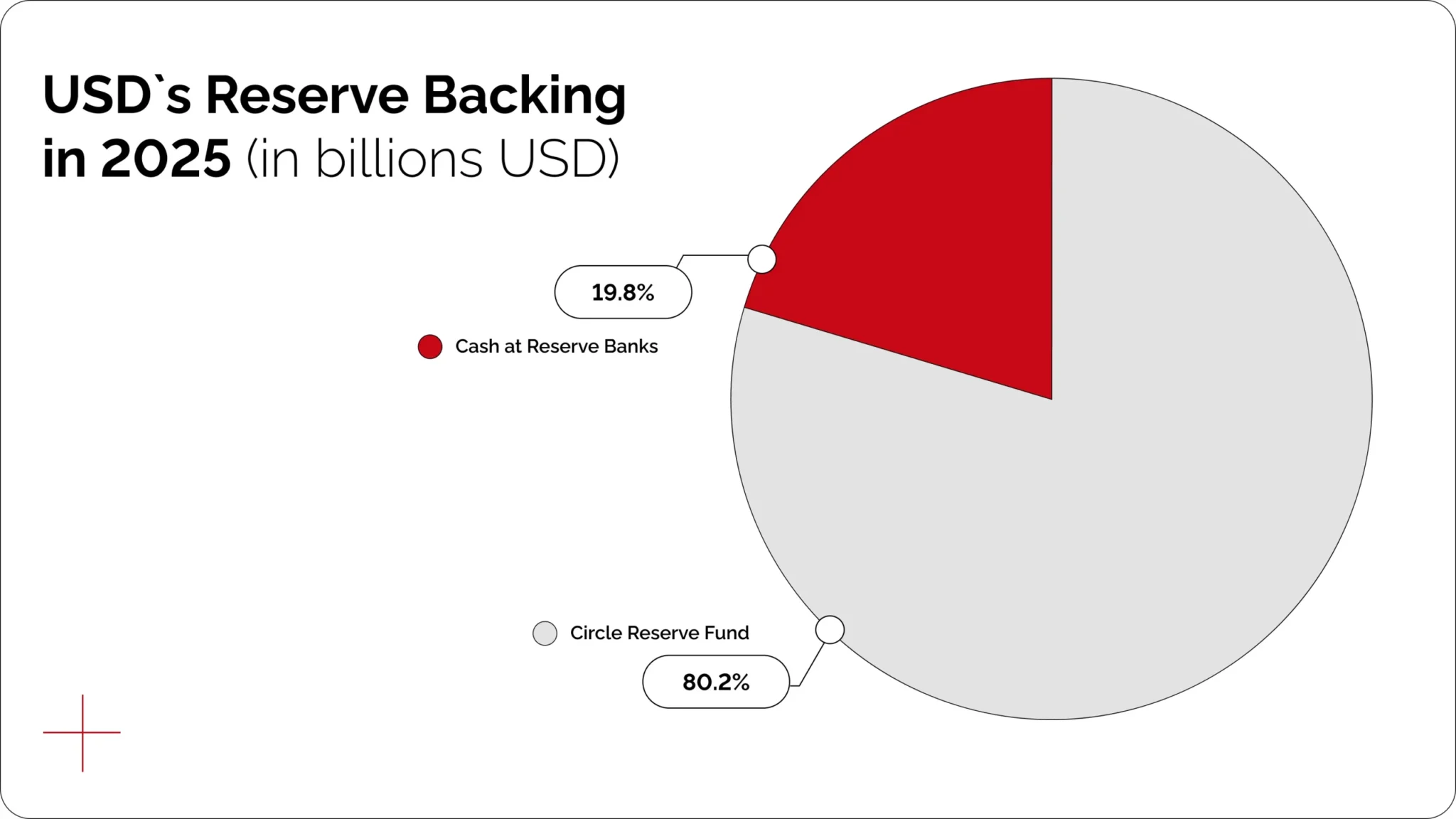
USDT, in contrast, has a long history of controversy. While Tether now provides quarterly reports, its reserve mix is far more opaque and includes not only T-bills but also corporate bonds, precious metals, Bitcoin, and other investments. This aggressive strategy is likely profitable for Tether, but it wouldn't fly under the strict definitions of the GENIUS Act.
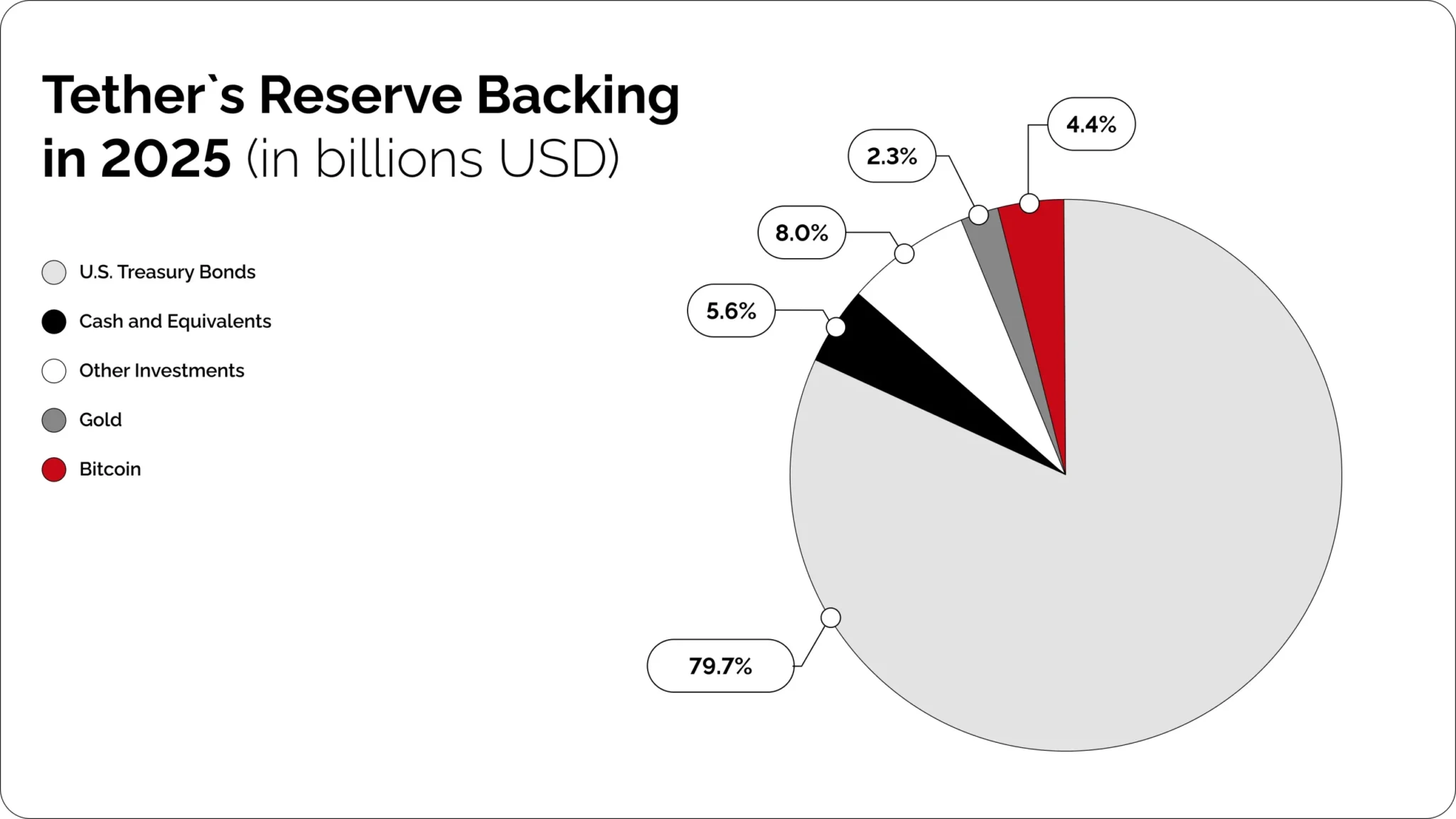
"While USDT is the more popular stablecoin, many investors argue that USDC is a better option due to better transparency and regulatory compliance." - CoinLedger
Round 2: Regulation, Compliance, and Censorship
USDC has always played the long game of proactive compliance. As a regulated U.S. entity, Circle actively collaborates with law enforcement and has the power to freeze assets associated with illicit activity—a power it has used many times. This makes it the de facto "institutional dollar" for regulated, onshore activities like B2B payments and corporate treasury management.
USDT has historically had a more adversarial relationship with regulators, operating from an offshore base in a legal gray area. While Tether also cooperates with law enforcement, its recent announcement of a separate, fully compliant, U.S.-domiciled stablecoin is a clear admission that its flagship USDT product isn't designed for the new American paradigm. This has led to a great bifurcation: USDC is the choice for regulated U.S. business, while USDT remains the "trader's dollar" for offshore markets where speed is prioritized over regulatory certainty.
Round 3: Market Dominance, Liquidity & Network Support
On raw metrics, USDT is still the undisputed king. It holds over 65% of the total stablecoin market share and boasts the highest trading volume, ensuring unmatched liquidity. A key driver is its dominance on the Tron (TRX). Transactions on Tron are lightning-fast and cost mere cents, making zero-fee-transactions the go-to for high-volume, low-value transfers and remittances.
USDC is the clear number two, with about 20-25% market share. While its trading volume is lower, it often sees higher on-chain transaction volume. It is the preferred stablecoin within the decentralized finance (DeFi) ecosystem, especially on Ethereum and its Layer-2 scaling solutions like Polygon, Base, and Arbitrum.
The key takeaway is that the choice of blockchain is now as critical as the choice of stablecoin. A business needing to process thousands of micropayments will find USDT on Tron exponentially more economical. A DeFi developer will find deeper liquidity with USDC on an L2.
The New Wave of Regulated Giants: PYUSD & RLUSD Enter the Arena
The clarity from the GENIUS Act has emboldened giants from traditional finance to launch their own stablecoins, creating formidable competitors for the regulated enterprise market.
PayPal's PYUSD: The Consumer & Commerce Stablecoin
Launched by payments behemoth PayPal and issued by the NYDFS-regulated Paxos, PayPal USD (PYUSD) is engineered for mass adoption. Its superpower is its deep, native integration into PayPal's colossal ecosystem of over 400 million accounts and Venmo. This creates a frictionless bridge for mainstream users to on-ramp from their bank, send fee-free P2P transfers, and use PYUSD at checkout. Available on both Ethereum and Solana (SOL), PYUSD is poised to become the dominant stablecoin for consumer payments and e-commerce.
Ripple's RLUSD: The Enterprise & Cross-Border Specialist
Ripple's RLUSD enters the market with a laser focus on the institutional sector. Its unique advantage stems from Ripple's decade of experience building blockchain solutions for financial institutions. RLUSD is purpose-built for B2B cross-border payments and is issued natively on two blockchains: the XRP Ledger for high speed and low costs, and Ethereum for access to its vast ecosystem. This positions RLUSD as the trusted digital dollar for institutional finance.
The arrival of PYUSD and RLUSD marks a critical evolution. The new battleground is for the "rails"—the distribution networks. USDC's strength is DeFi, PYUSD's is the consumer payment network, and RLUSD's is the global banking network.
The Decentralized & Innovative Challengers: DAI, USDe, FRAX
For users who prioritize decentralization and censorship resistance, a vibrant ecosystem of alternatives offers compelling options.
DAI: The Battle-Tested Decentralized Veteran
As one of the oldest and most respected decentralized stablecoins, DAI is governed by the MakerDAO community. Its peg is maintained not by fiat reserves, but by being over-collateralized with a diverse basket of crypto assets in transparent smart contracts. This makes DAI highly resistant to censorship from any single company or government. However, to enhance stability, a significant portion of its collateral is now centralized stablecoins like USDC, creating a "decentralization paradox."
USDe: The High-Yield "Synthetic Dollar" and Its Inherent Risks
Ethena's USDe is a radical departure. It’s a "synthetic dollar" that maintains its peg through a delta-neutral hedging strategy. The primary allure is its ability to generate a substantial native yield, often in the double digits, derived from staking rewards and perpetual futures funding rates.
However, this innovative model introduces a complex set of risks:
- Funding Risk: The model relies on funding rates remaining positive. A sustained period of negative rates could place significant pressure on the peg.
- Counterparty Risk: The hedges are held on centralized exchanges. The failure of an exchange, like the FTX collapse, could be catastrophic.
- Collateral Risk: The model relies on liquid staking tokens (like stETH) maintaining their peg to the underlying asset (ETH).
USDe is best suited for sophisticated DeFi users who understand and can manage these risks in exchange for high returns.
FRAX: The Dynamic Fractional-Algorithmic Hybrid
FRAX is the most prominent fractional-algorithmic stablecoin. Its supply is backed by a combination of hard collateral (like USDC) and its native governance token, Frax Shares (FXS). The protocol's dynamic Collateral Ratio (CR) adjusts based on market demand, allowing the market itself to determine the level of collateralization it trusts at any given moment.
Specialized Use Cases: FDUSD and PAXG
Beyond the mainstream, several assets serve specific niche markets.
FDUSD: The Hong Kong-Regulated Contender
First Digital USD (FDUSD) is a fiat-backed stablecoin issued by a trust company licensed in Hong Kong. Its primary value is its direct alignment with the Hong Kong Monetary Authority's (HKMA) emerging regulatory framework, positioning it to become a key compliant stablecoin for the Asian market. For businesses focused on this region, it's a compelling option.
PAXG: A Hedge Against Fiat, Not a Replacement
Pax Gold (PAXG) is a commodity-backed stablecoin. Each token represents direct legal ownership of one fine troy ounce of a London Good Delivery gold bar, stored in secure, audited vaults. It digitizes gold ownership, making it divisible, easily transferable, and free from high storage fees. Because its value is tied to the real-time market price of gold, it's an excellent tool for hedging against inflation but is not suitable for daily transactions denominated in U.S. dollars.
The Ultimate Comparison: A Decision-Making Framework for 2025
The stablecoin landscape of 2025 is multifaceted. The optimal choice depends entirely on your priorities. The following framework provides a structured approach to making an informed decision.
For Active Traders: Prioritizing Liquidity and Low Fees
For high-frequency trading, liquidity and transaction cost are everything. USDT, particularly on the TRON (TRX), remains the undisputed choice. For on-chain trading within DeFi, USDC on low-cost networks like Solana (SOL) or Base is the preferred alternative.
For Businesses & Merchants: Prioritizing Compliance and Integration
For any business operating in the U.S., the GENIUS Act makes compliance non-negotiable. The clear winners are USDC, PYUSD, and RLUSD. These are designed for seamless integration with enterprise-grade payment infrastructure, enabling low-cost, 24/7 global settlement for e-commerce, B2B payments, and treasury operations. For businesses weighing their options between self-hosted solutions, it's also useful to see how different gateways stack up, for example, in our comparison of Payram vs BTCPay Server.
For DeFi Power Users: Prioritizing Decentralization and Yield
Users who operate primarily within DeFi have different priorities.
- DAI remains the premier choice for those who prioritize decentralization.
- USDe is tailored for high-risk, sophisticated users seeking native yield.
- FRAX appeals to users interested in participating in a capital-efficient, algorithmic ecosystem.
For Long-Term Savers & Treasury Management: Prioritizing Stability and Trust
For individuals or corporate treasuries, the safety of the reserves is paramount. USDC stands out as the top choice for a stable, transparent, and regulated digital dollar savings vehicle. For hedging against fiat currency inflation, PAXG offers direct, digital ownership of physical gold.
The Future of Stablecoins: A Post-GENIUS Act World
The GENIUS Act was not an endpoint but a starting gun. This newfound regulatory clarity is the primary catalyst unlocking the floodgates of institutional adoption. For years, large corporations have been hesitant to engage with stablecoins. The GENIUS Act provides the confidence needed for them to begin integrating stablecoin payments into core operations.
While the U.S. has established its framework, a global regulatory patchwork is emerging. The European Union's Markets in Crypto-Assets (MiCA) regulation is now in effect, and hubs like Hong Kong and Singapore have introduced their own rules. This will lead to a strategy of using different compliant stablecoins for different regions.
Frequently Asked Questions (FAQs)
1. What is the safest stablecoin?
Safety depends on your definition of risk. For regulatory safety and transparency, USDC is often considered the leader due to its U.S. regulation and monthly audits by a Big Four accounting firm. For decentralization and censorship resistance, DAI is a strong contender, though it carries smart contract and collateral risks.
2. Can stablecoins lose their value?
Yes. While designed to be stable, they can "de-peg" from their $1 value. This can happen due to a loss of confidence in the issuer's reserves, a major market crisis, or flaws in an algorithmic model. Both USDT and USDC have experienced brief de-pegging incidents in the past but have managed to recover.
3. What's the main difference between USDT and USDC?
The primary difference lies in transparency and regulation. USDC is issued by a U.S.-regulated company (Circle), provides regular, detailed audits of its reserves, and has a strong compliance focus. USDT is issued by an offshore entity (Tether), has a more opaque and diversified reserve portfolio, and has faced more regulatory scrutiny over the years.
4. Why are transaction fees different for the same stablecoin?
Transaction fees are determined by the blockchain network the stablecoin is running on, not the stablecoin itself. For example, sending Ethereum (ETH) can be expensive due to high gas fees, while sending the exact same Tron (TRX) can cost just a few cents.
5. Are algorithmic and synthetic stablecoins like USDe risky?
Yes, they carry unique risks. Purely algorithmic stablecoins can be vulnerable to "death spirals" if market confidence collapses. Synthetic dollars like USDe depend on complex financial strategies (like futures funding rates) which can fail or become unprofitable in certain market conditions, and they also have counterparty risk with the exchanges where they place their hedges.
6. Can I use stablecoins for everyday purchases?
It's becoming more common. PYUSD is deeply integrated into the PayPal and Venmo ecosystems, allowing users to pay at millions of online merchants. Additionally, many crypto debit cards allow you to spend your stablecoin balance wherever major card networks like Visa are accepted.
7. How do stablecoin issuers like Tether and Circle make money?
They earn interest and yield on the massive reserves they hold. For example, if an issuer holds billions of dollars in U.S. Treasury bills, they collect the interest paid by those government bonds. This can be an extremely profitable business model.
8. What is the GENIUS Act in simple terms?
The The GENIUS Act is a landmark U.S. law passed in 2025 that creates a federal regulatory framework for U.S. dollar-backed stablecoins. It requires issuers to be regulated, hold 1:1 reserves in safe assets like cash and T-bills, and provide regular public reports, aiming to make stablecoins safer for consumers and businesses.
9. Is DAI truly decentralized if it uses USDC as collateral?
This is known as the "decentralization paradox." While DAI's governance and operation are decentralized through the MakerDAO protocol, a significant portion of its collateral is USDC, a centralized stablecoin. This means DAI indirectly inherits some of the centralization and censorship risks of USDC.
10. Why would I use a gold-backed stablecoin like PAXG instead of just buying gold?
PAXG digitizes gold ownership. It allows you to own fractions of a large gold bar, transfer it instantly 24/7 anywhere in the world on the blockchain, and avoid the high costs and logistical challenges of storing and insuring physical gold bullion.
Conclusion
The era of a one-size-fits-all stablecoin is over. The market has fragmented into distinct categories, each tailored to a specific use case and regulatory philosophy. The choice is now a critical strategic decision.
For regulated, onshore commerce within the U.S., the future belongs to compliant issuers like USDC, PYUSD, and RLUSD. For liquid, high-velocity trading in offshore environments, USDT's network effect remains unmatched. For the pioneers of decentralized finance, DAI, USDe, and FRAX offer a landscape of innovation and yield. Finally, for investors seeking a digital hedge, commodity-backed tokens like PAXG provide a direct link to hard assets.
The next wave of innovation will not be in creating new pegs, but in building the applications, payment rails, and treasury systems on top of these newly legitimized digital dollars. For any business operating in the digital economy, understanding this landscape and choosing the right stablecoin for the job is no longer just an option—it is a strategic imperative.
Ready to navigate this new landscape and implement the right stablecoin strategy for your business?


.svg)



.png)




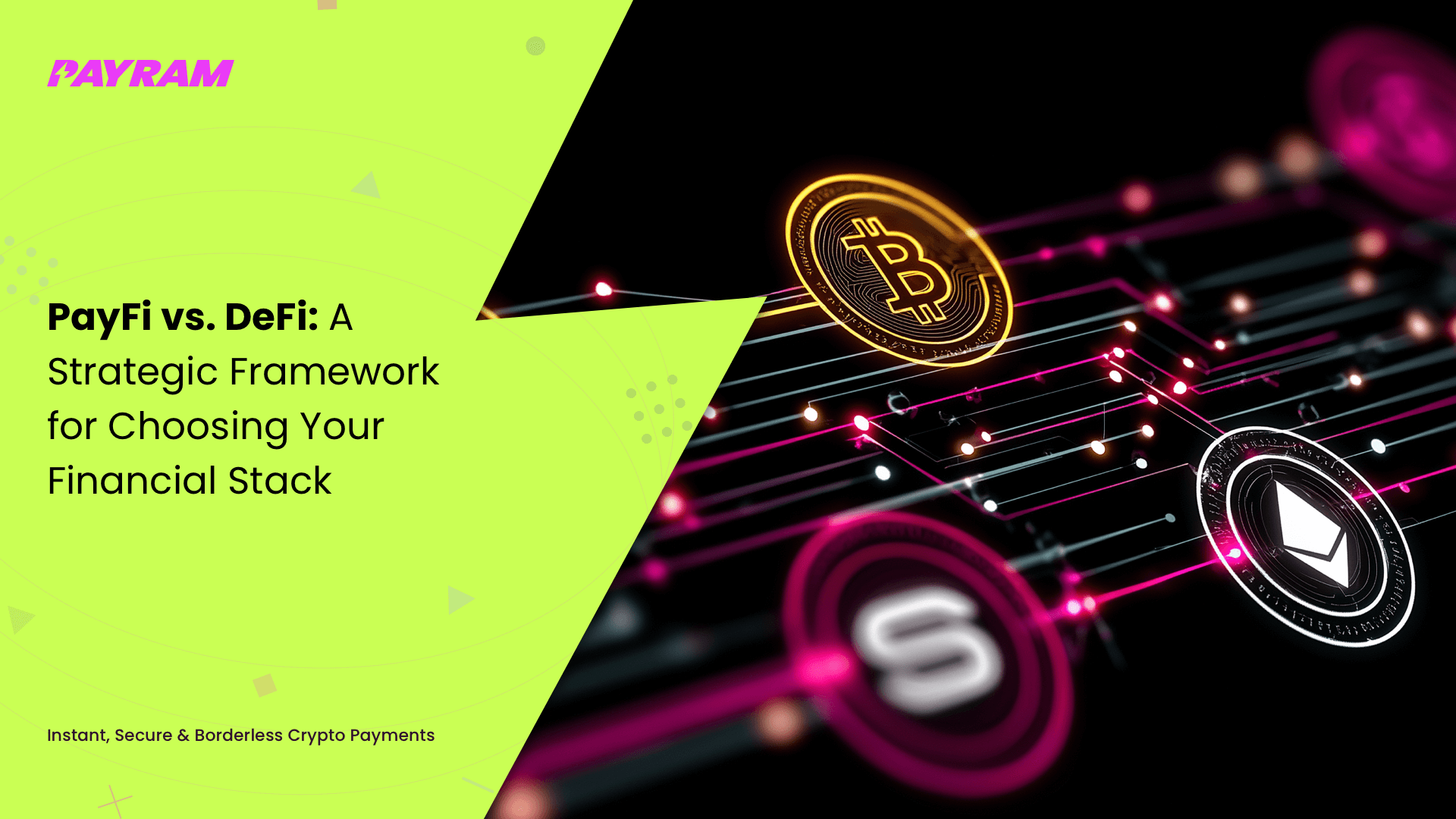

.svg)